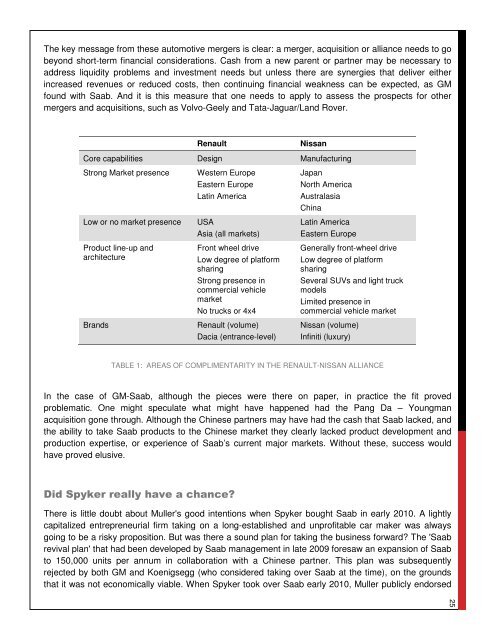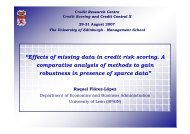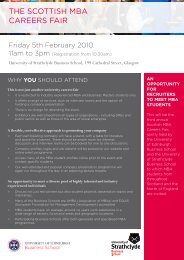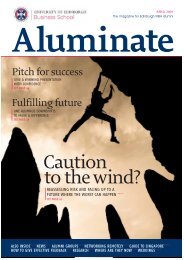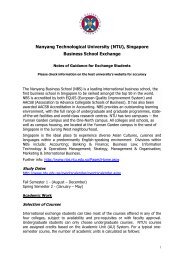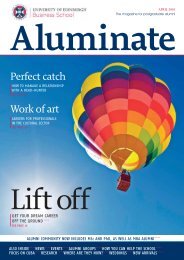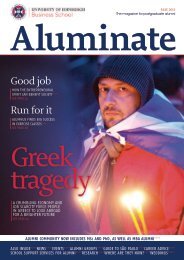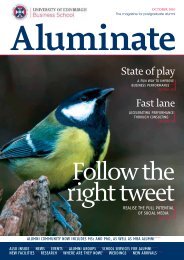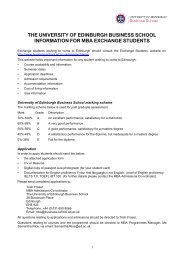killed Saab Automobile? - Business School - University of Edinburgh
killed Saab Automobile? - Business School - University of Edinburgh
killed Saab Automobile? - Business School - University of Edinburgh
Create successful ePaper yourself
Turn your PDF publications into a flip-book with our unique Google optimized e-Paper software.
The key message from these automotive mergers is clear: a merger, acquisition or alliance needs to go<br />
beyond short-term financial considerations. Cash from a new parent or partner may be necessary to<br />
address liquidity problems and investment needs but unless there are synergies that deliver either<br />
increased revenues or reduced costs, then continuing financial weakness can be expected, as GM<br />
found with <strong>Saab</strong>. And it is this measure that one needs to apply to assess the prospects for other<br />
mergers and acquisitions, such as Volvo-Geely and Tata-Jaguar/Land Rover.<br />
Renault Nissan<br />
Core capabilities Design Manufacturing<br />
Strong Market presence Western Europe<br />
Low or no market presence USA<br />
Product line-up and<br />
architecture<br />
Eastern Europe<br />
Latin America<br />
Asia (all markets)<br />
Front wheel drive<br />
Low degree <strong>of</strong> platform<br />
sharing<br />
Strong presence in<br />
commercial vehicle<br />
market<br />
No trucks or 4x4<br />
Brands Renault (volume)<br />
Dacia (entrance-level)<br />
Japan<br />
North America<br />
Australasia<br />
China<br />
Latin America<br />
Eastern Europe<br />
Generally front-wheel drive<br />
Low degree <strong>of</strong> platform<br />
sharing<br />
Several SUVs and light truck<br />
models<br />
Limited presence in<br />
commercial vehicle market<br />
Nissan (volume)<br />
Infiniti (luxury)<br />
TABLE 1: AREAS OF COMPLIMENTARITY IN THE RENAULT-NISSAN ALLIANCE<br />
In the case <strong>of</strong> GM-<strong>Saab</strong>, although the pieces were there on paper, in practice the fit proved<br />
problematic. One might speculate what might have happened had the Pang Da – Youngman<br />
acquisition gone through. Although the Chinese partners may have had the cash that <strong>Saab</strong> lacked, and<br />
the ability to take <strong>Saab</strong> products to the Chinese market they clearly lacked product development and<br />
production expertise, or experience <strong>of</strong> <strong>Saab</strong>’s current major markets. Without these, success would<br />
have proved elusive.<br />
Did Spyker really have a chance?<br />
There is little doubt about Muller's good intentions when Spyker bought <strong>Saab</strong> in early 2010. A lightly<br />
capitalized entrepreneurial firm taking on a long-established and unpr<strong>of</strong>itable car maker was always<br />
going to be a risky proposition. But was there a sound plan for taking the business forward? The '<strong>Saab</strong><br />
revival plan' that had been developed by <strong>Saab</strong> management in late 2009 foresaw an expansion <strong>of</strong> <strong>Saab</strong><br />
to 150,000 units per annum in collaboration with a Chinese partner. This plan was subsequently<br />
rejected by both GM and Koenigsegg (who considered taking over <strong>Saab</strong> at the time), on the grounds<br />
that it was not economically viable. When Spyker took over <strong>Saab</strong> early 2010, Muller publicly endorsed<br />
25


